
Canadians have another facet of national defence right under our noses
The current trade war with the U.S. means Canada must confront whether its domestic food...
The air is thick with wildfire smoke as a Tsleil-Waututh Nation field crew readies their boat for a trip into the north arm of səl̓ilw̓ət, the waterway settlers have come to call Burrard Inlet. It’s October 2022, two and half years into the pandemic, so it’s not unusual to see people wearing masks. But the concern today isn’t so much the virus, as the degraded air quality. Fuelled by an unusually dry fall, fires are raging to the south, cloaking a vast area in an eerie veil of smoke.
Any other day the three-person crew of Haley Crozier, Travis George and Charlie George, may have decided to stay indoors, but the community is relying on them. The samples they collect will decide whether Tsleil-Waututh Nation can harvest clams from the inlet and — even just once this year — eat them without the threat of illness.
So, they mask up, push off from the dock at the Deep Cove marina and head northeast, towards the hazy wall of mountains.
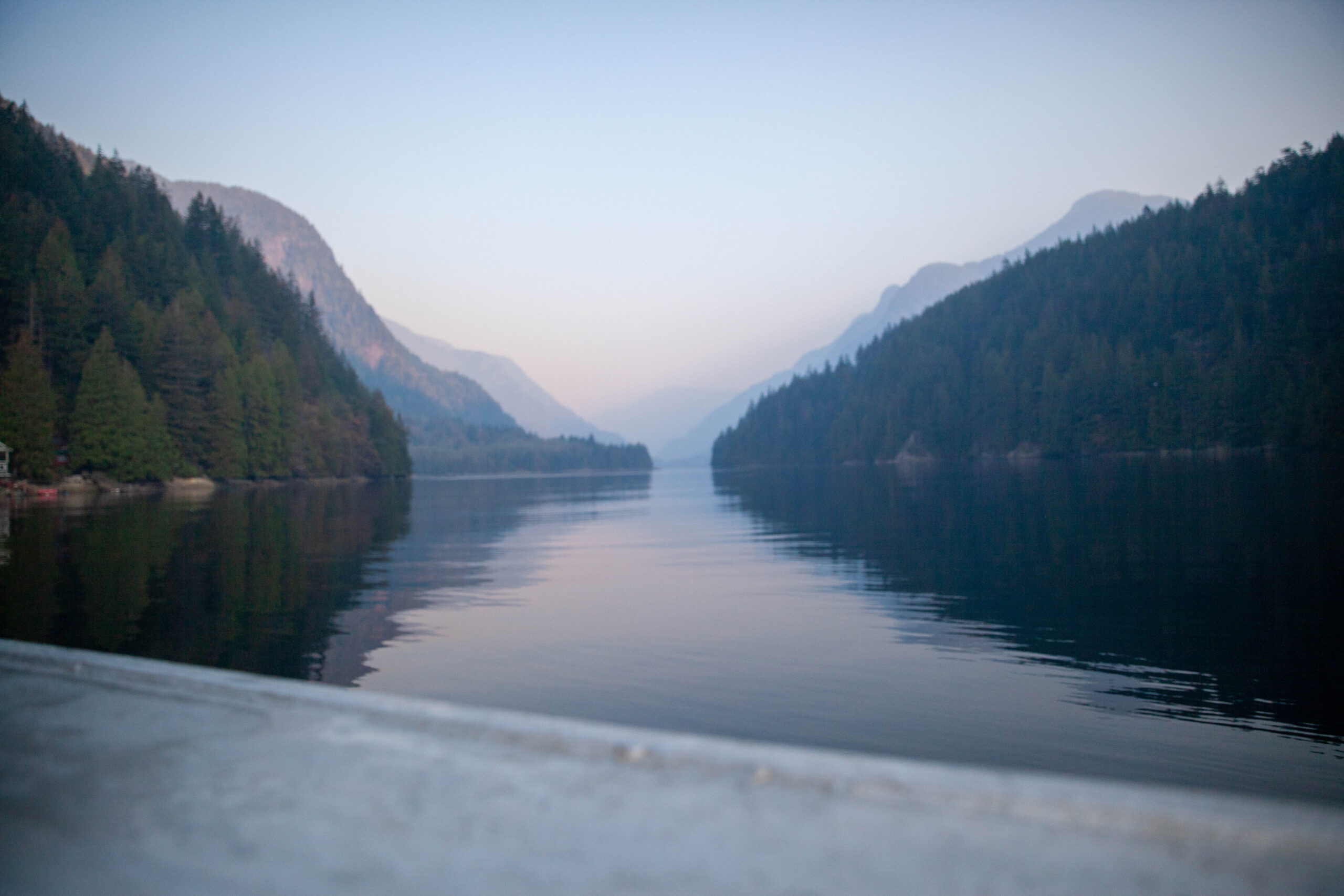
Burrard Inlet separates the Fraser Lowlands, now home to Vancouver and surrounding cities, from the mountains of the North Shore. Some 15 kilometres inland from the first narrows, it splits. As one arm reaches farther east to Port Moody, B.C., the other stretches north, to the mouth of the Indian River (xʔəl̓ilwətaʔɬ). The fjord falls within the traditional and unceded territories of Tsleil-Waututh (səlilwətaɬ), Squamish (Sḵwx̱wú7mesh Úxwumixw) and Musqueam (xʷməθkʷəy̓əm) Nations.
These waters, səl̓ilw̓ət, are integral to Tsleil-Waututh Nation’s history and culture. In the hən̓q̓əmin̓əm̓ language, səlilwətaɬ means People of the Inlet, a reflection of the deep connections between the people and the place.
“Oral history tells me that my first grandmother comes from the inlet,” Michelle George, a Tsleil-Waututh member and cultural technical specialist with the nation’s Treaty, Lands and Resources department tells The Narwhal. For millennia, the nation and the inlet lived in harmony. People took only what they needed, Michelle says, they understood the “balance of life.”
Over the last several years, Tsleil-Waututh Nation and a team of researchers have drawn on oral history, Traditional Knowledge, old maps and archival records to paint a picture of the inlet from the past.
Their work is crucial for understanding the degree of degradation that’s taken place over the last 200-plus years and the extent to which Tsleil-Waututh Nation’s rights are being infringed. At the same time, it offers hope for a future where the inlet, though changed, can flourish once again.
At one time, the rivers rushing down the North Shore mountains fanned into lush, overlapping estuaries. Vast stretches of beach gave way to vibrant green eelgrass meadows and thick forests of kelp.
Salmon started and ended their lives in these rivers and creeks in numbers unheard of today. Clams, tended in coastal gardens, were not only plentiful but safe to eat. And shimmering schools of herring, which spawned throughout the inlet, would have painted the waters a stunning milky turquoise each year.
“There are tales and stories of where you could walk out on the backs of the fish and never touch the water, where the trees are big enough to build a house and canoe and maybe another canoe for your whole family from one tree,” Michelle says.
Today, much of the shoreline has been dug out and filled in and hardened with stone and concrete. The mouths of the Capilano and Seymour rivers are constricted into narrow channels. Marine terminals, oil refineries and chemical plants flank the waterway, which has become a thoroughfare for tankers and cruise ships. During heavy rainstorms, untreated sewage and runoff from city streets still pour into the inlet, adding to the contaminant cocktail.
Tsleil-Waututh Nation is confronted by the industrialization of səl̓ilw̓ət daily. The view from just outside the nation’s administration building is of the Burnaby oil refinery, with its billowing clouds of steam and orange flames flickering from a flare stack.
Even inside, there’s often no escaping the sounds of industry. Sitting in the nation’s Council Chambers in April, Councillor Charlene Aleck pauses for a moment. “You can’t hear the pile-driving today,” she says. But construction noise from the Westridge Marine Terminal, just east of the refinery, where diluted bitumen from the Trans Mountain pipeline is loaded onto tankers, regularly echoes throughout the building.
This devastating transformation, which Tsleil-Waututh Nation and its research team documented in a series of reports, unfolded incrementally through colonization — “like death by paper cut after paper cut after paper cut,” Michelle says.
No single entity is responsible for every impact to the inlet; instead, a hodgepodge of government agencies has authority over bits and pieces. Tsleil-Waututh Nation says not enough attention is paid to the combined impacts of all past and present pressures on the waterway or the toll it’s taken on the plants, animals and people who call this place home.
It’s an issue across B.C. In the Northeast, Blueberry River First Nation eventually took the B.C. government to court over the cumulative impacts of industry in their territory. In a landmark 2021 decision, the court ruled the province had “unjustifiably infringed” the nation’s Treaty Rights and couldn’t continue to allow activities that would further breach its obligations. In essence, the court acknowledged that “as more impacts accrue in a First Nation’s territory, development becomes ever-harder to justify under Canadian law,” Tsleil-Waututh noted in a recent report. And, in Burrard Inlet, the impacts are piling up.
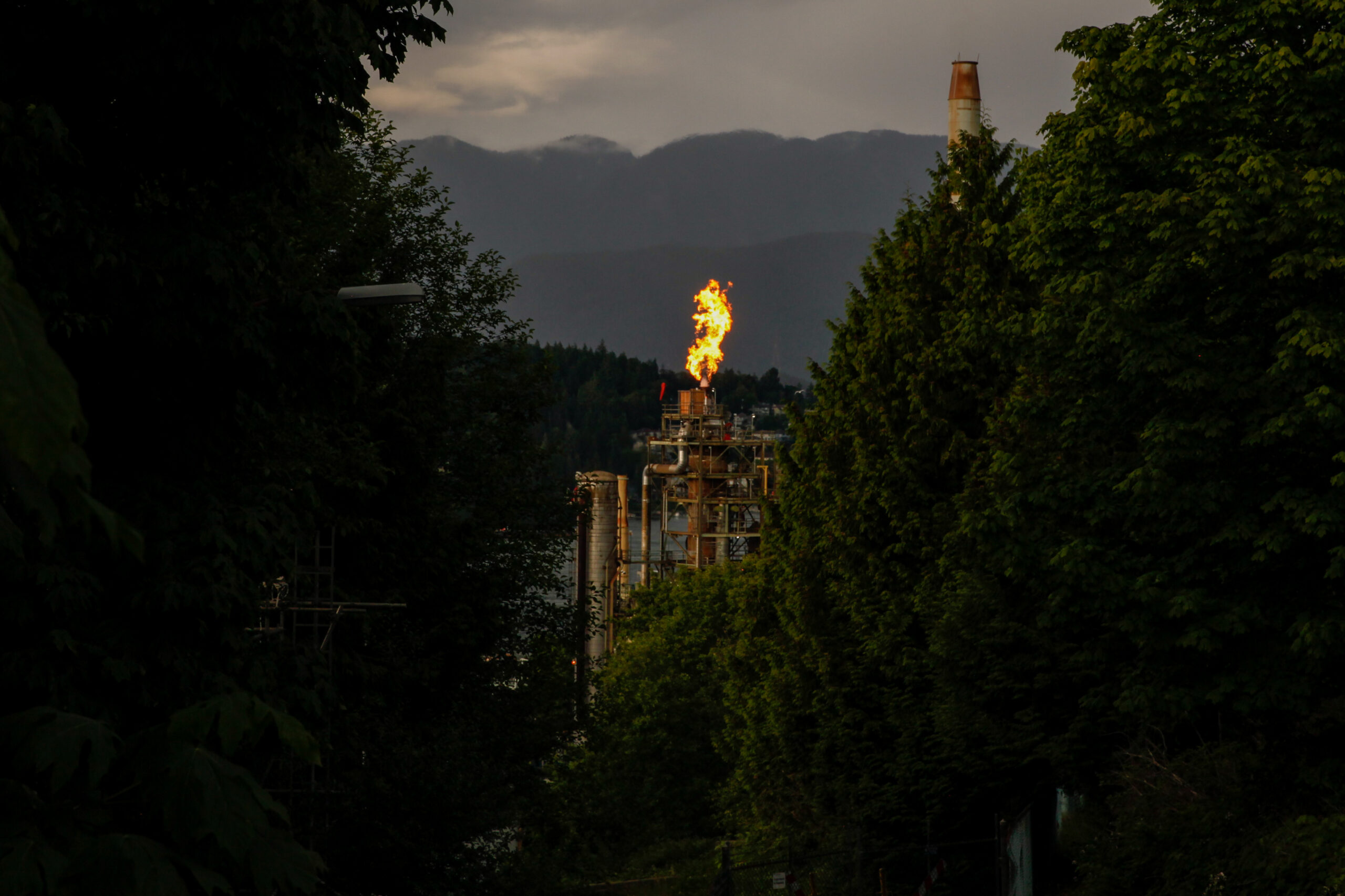
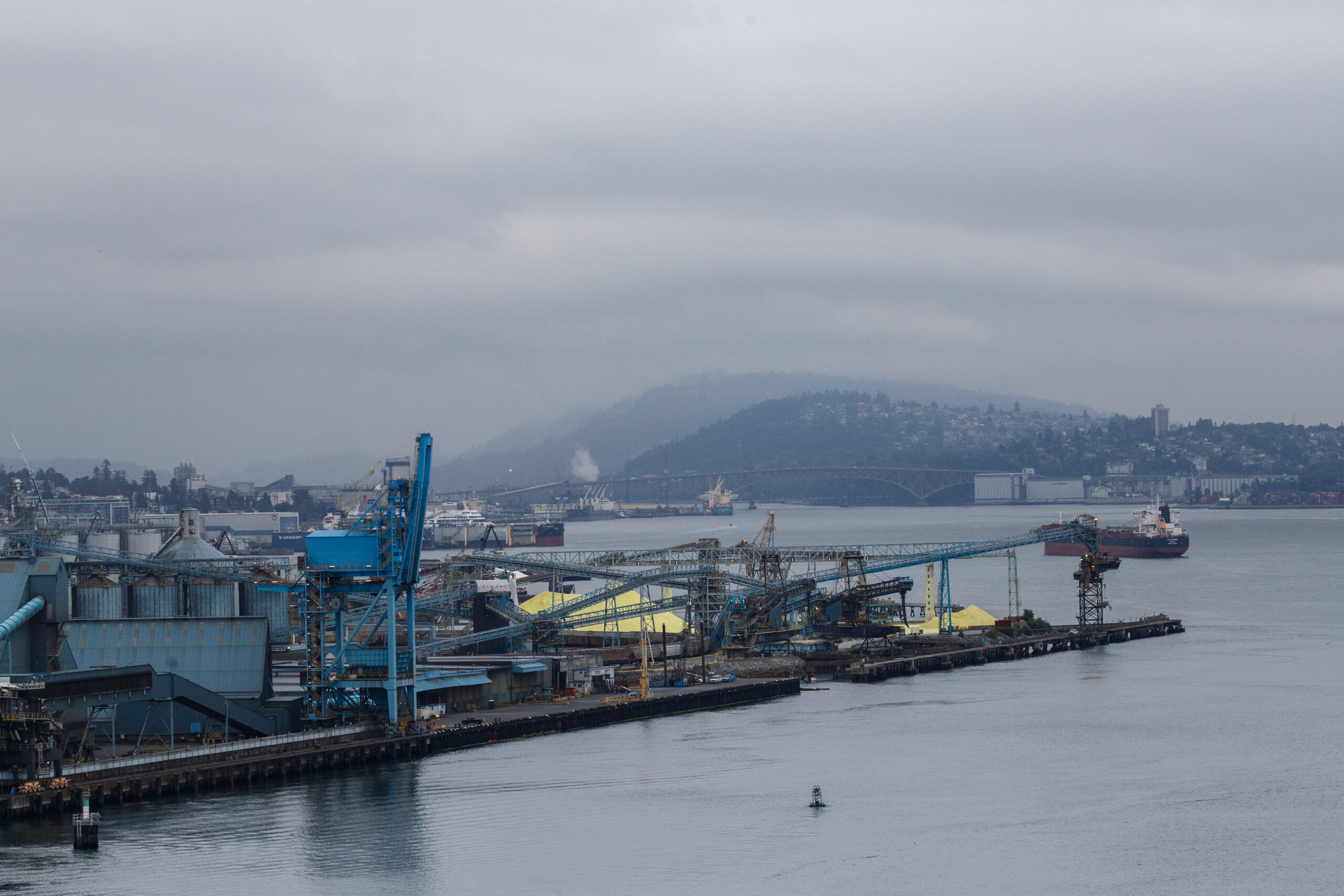
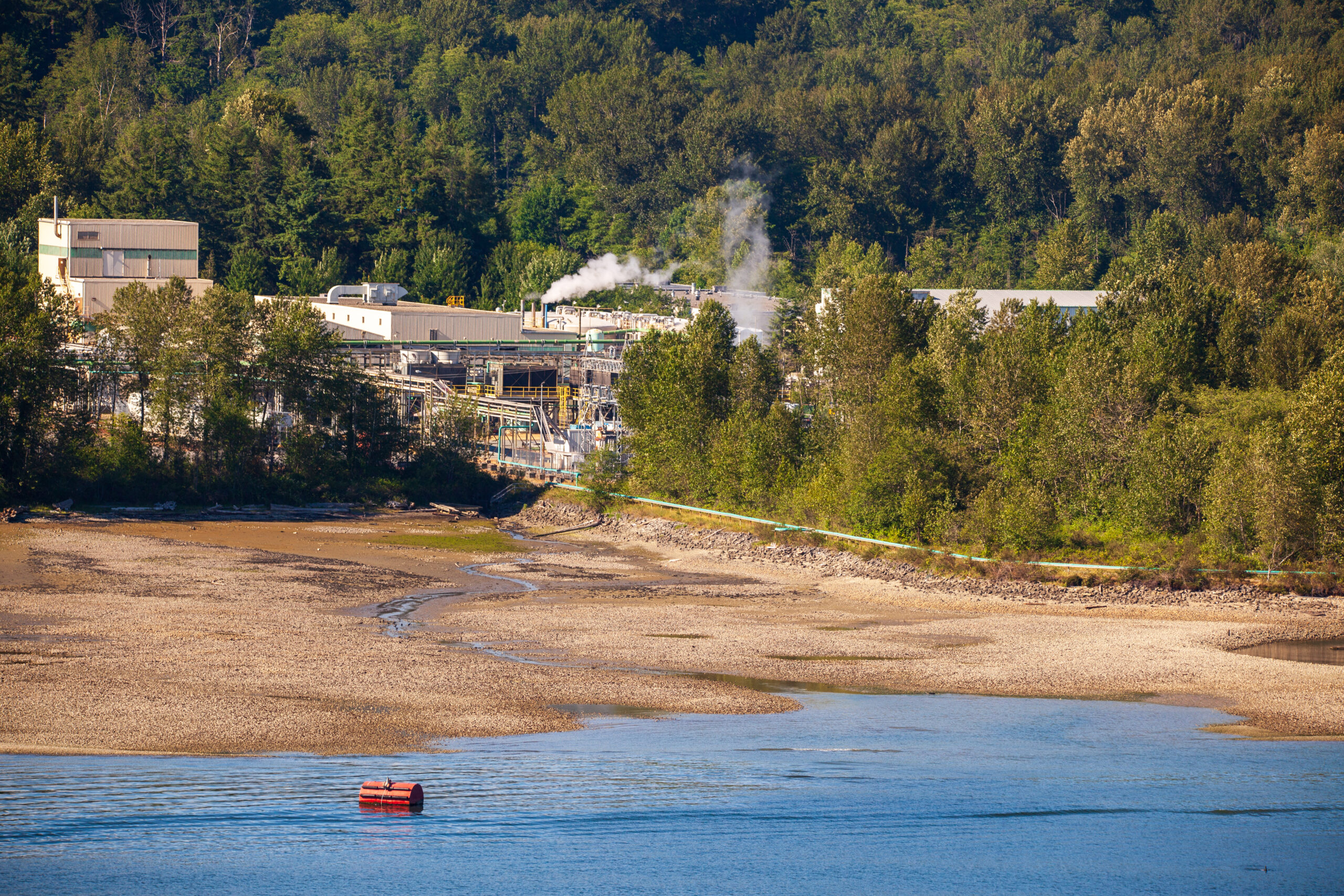
“We know that we can’t move forward without our neighbours,” Aleck says, but the nation wants “a seat at a decision-making table.” And not only on a project-by-project basis. The inlet needs to be looked at holistically.
Eugene Kung, a lawyer with West Coast Environmental Law who advises Tsleil-Waututh Nation, says the lack of consideration for cumulative impacts is a significant shortcoming of the current decision-making process.
“If we don’t get it right, it’s going to continue to hurl us towards climate and other ecological disasters,” he says.
Though the preference is to work out a new approach through negotiations, the courts are there as a last resort. The Blueberry River case “opens up a much clearer legal pathway,” Kung says.
For Michelle, it’s about making sure “there’s something here for future generations.”
Burrard Inlet has already lost 945 hectares of intertidal habitat — an area more than twice the size of Stanley Park — to the urbanization and industrialization of this region, according to a collaborative report from the Institute for the Oceans and Fisheries at the University of British Columbia and Tsleil-Waututh Nation.
What we see today is more like “a memory of an ecological system,” says Jesse Morin, an archeologist contracted by Tsleil-Waututh Nation to understand the historic ecology of Burrard Inlet. “There’s so little abundance compared to what there was.”
As settlers fished to excess, destroyed habitat and polluted the inlet, clams, herring, salmon and numerous other species suffered devastating declines.
Herring were one of the first to be killed off.
Rich in protein, herring was a staple food source for Tsleil-Waututh people and other marine life, but it was their oil that attracted the attention of colonial industries. For a time, the logging roads — used to haul enormous trunks from the forest — were greased with herring oil.
To process as many fish as quickly as possible, settlers tossed dynamite into the inlet. Within minutes of the blast hordes, of dead herring floated to the surface. Their bodies were scooped up, processed and dumped back into the sea.
Archival records show the practice was commonplace by 1881. And, within just a few years, herring populations in Burrard Inlet collapsed.
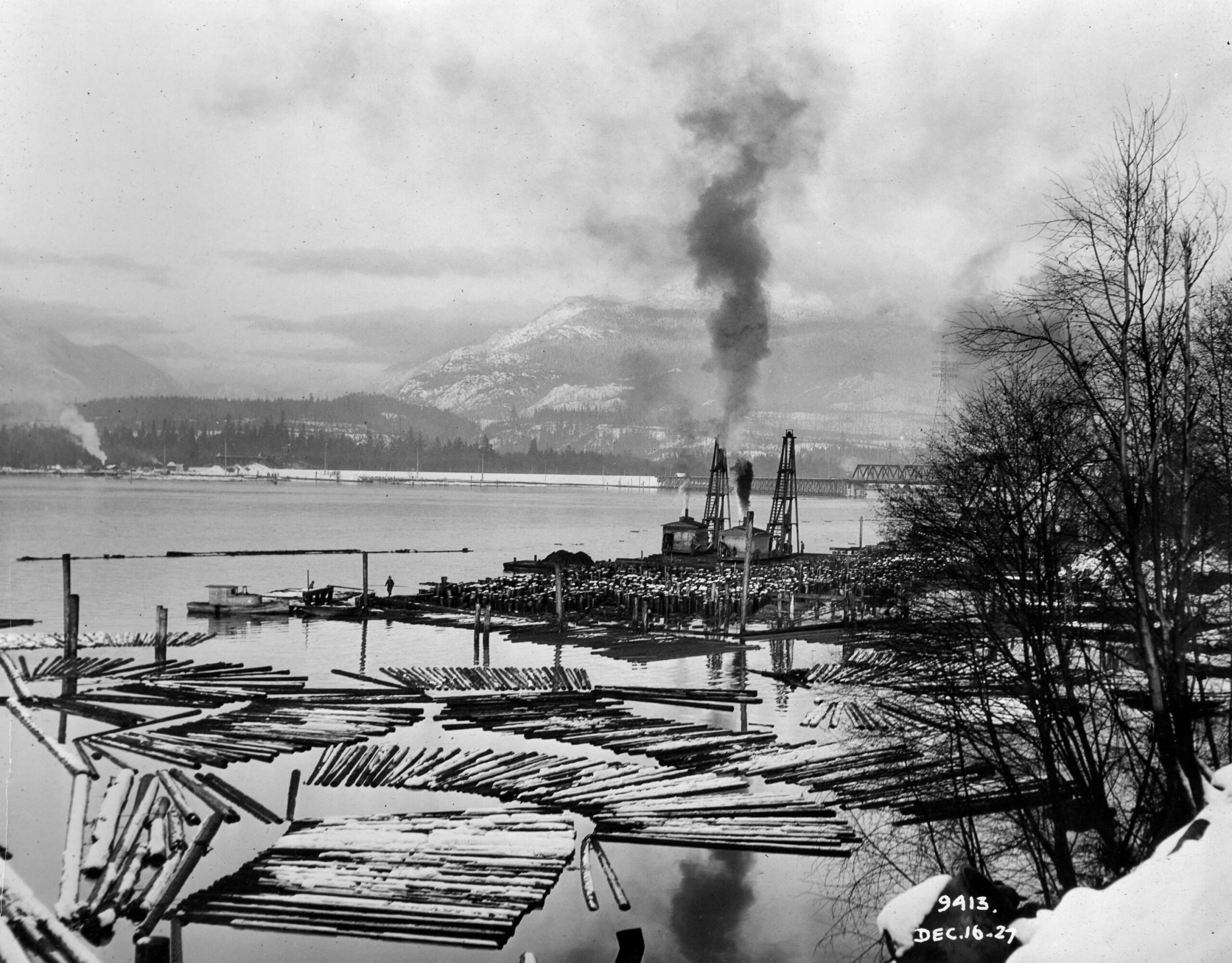
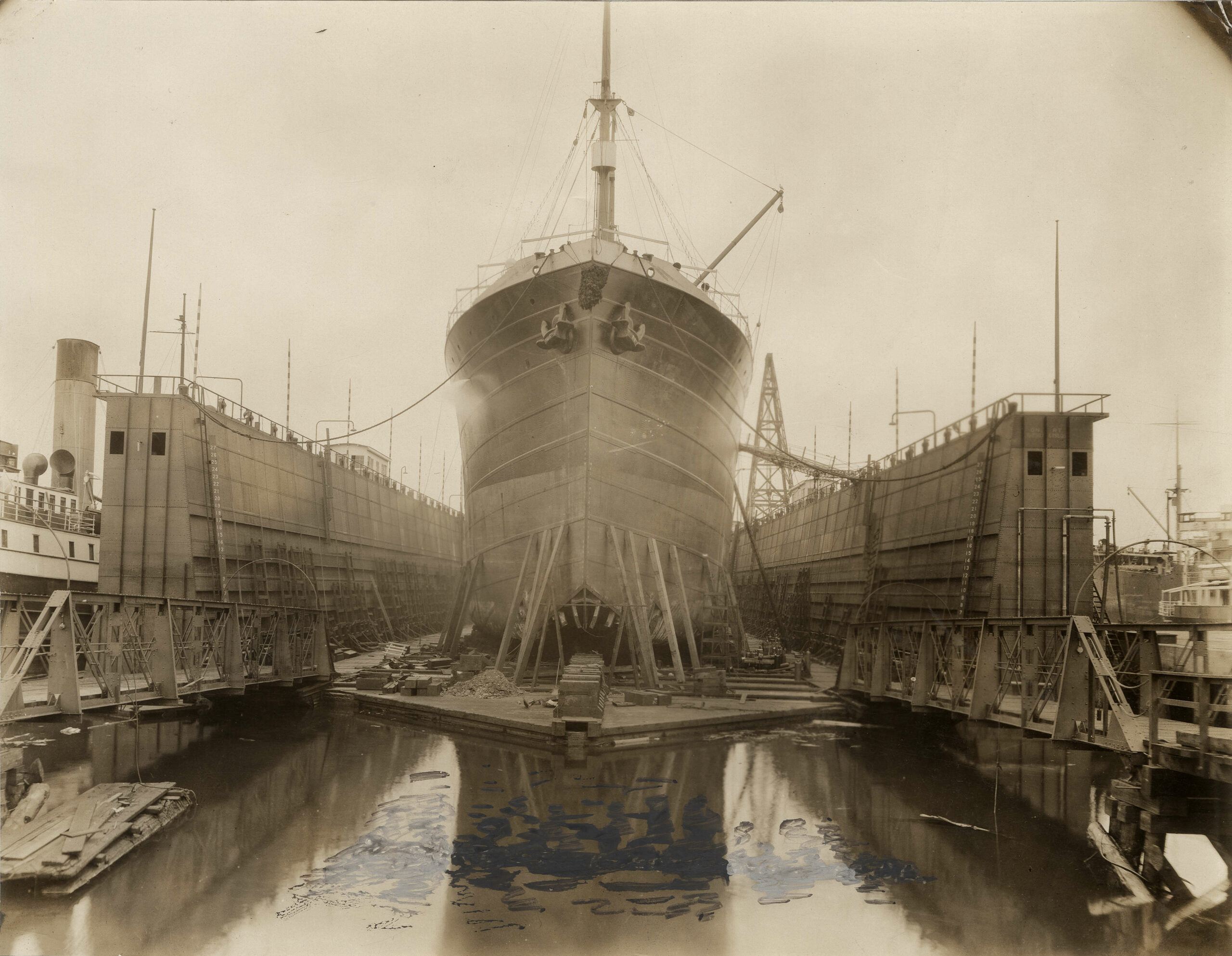
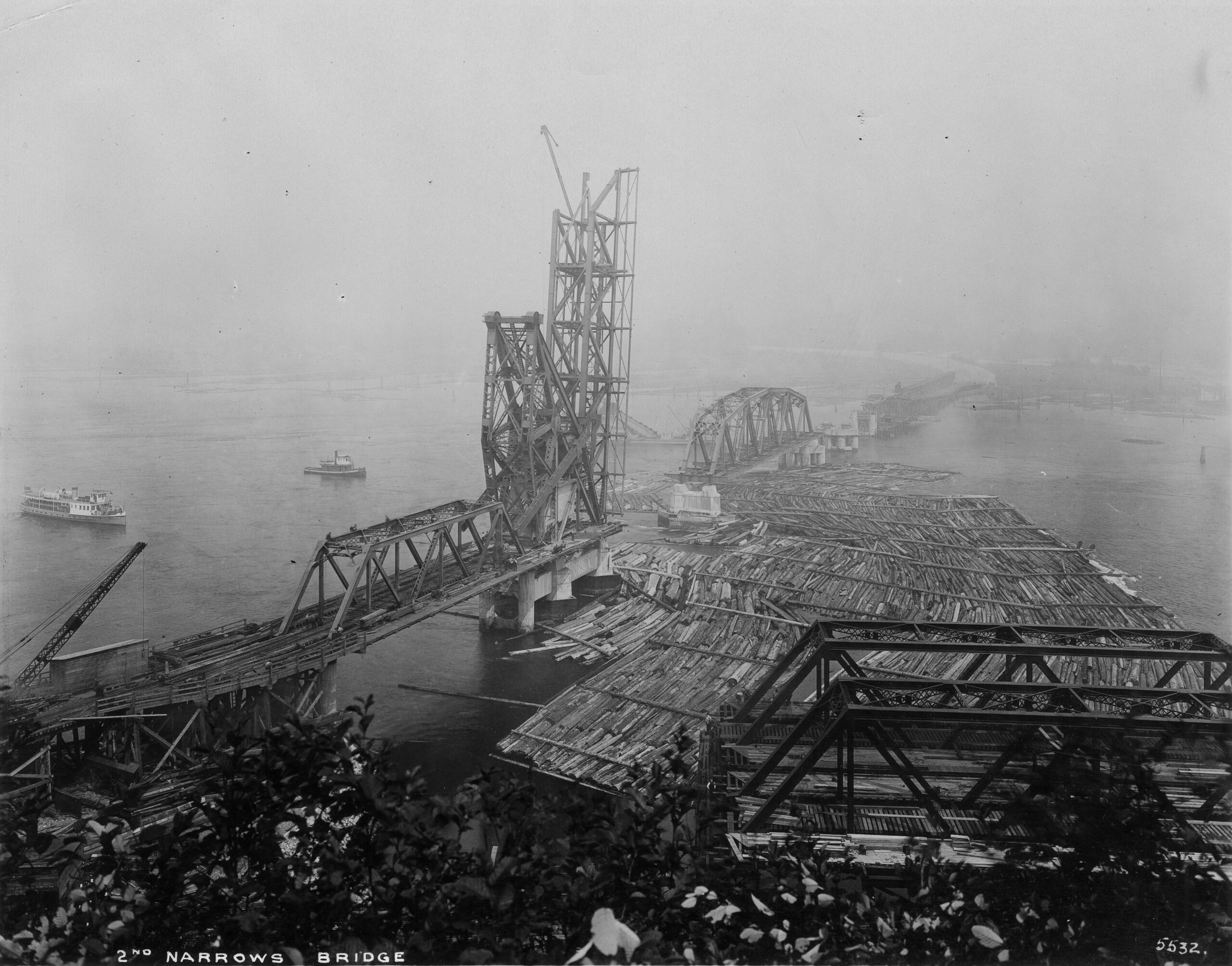
There was also a time when whales were so common in these waters that their population supported a small settler whaling industry in the outer harbour. But that collapsed too. “It seems likely that local whaling drove down whale populations in the late 19th century, then the extensive industrialization of Burrard Inlet dissuaded them from returning,” according to the report by the Institute for the Oceans and Fisheries and the nation.
It’s “another example of how incredibly abundant the ecosystem was historically and how it was just bled until there’s nothing left,” Spencer Taft, Tsleil-Waututh’s cumulative effects manager, tells The Narwhal.
Shellfish weren’t eliminated from the inlet, but it’s been a long time since they’ve been safe to eat.
Shellfish harvesting was officially banned in səl̓ilw̓ət in 1972 for public health reasons. But some Tsleil-Waututh people had grown wary of shellfish long before — too many people had already gotten sick.
Over the years, Burrard Inlet has been a dumping ground for household refuse, sewage and a toxic mix of industrial waste. There have been 700 different contaminants detected in these waters, according to a review of available data by Tsleil-Waututh Nation.
At least 24 pollutants detected in animal tissue — including heavy metals like arsenic, lead and mercury, pesticides and known carcinogens — are found at levels that make it dangerous for people to eat food from these waters at any substantial rates.
It’s hard to pinpoint exactly which oil refinery or sewage overflow tipped the scales. Taft says that’s like asking “which raindrop caused the flood?”
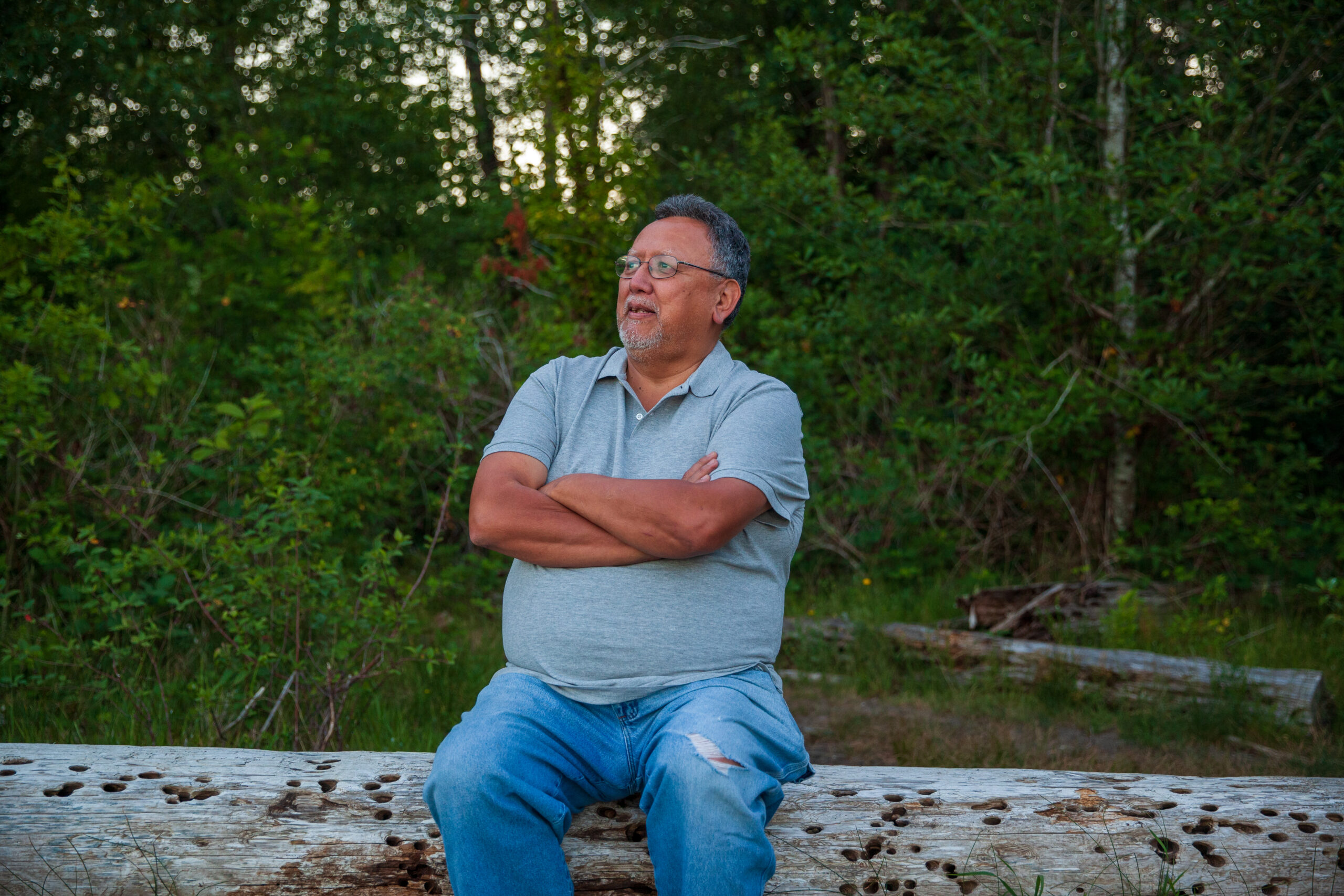
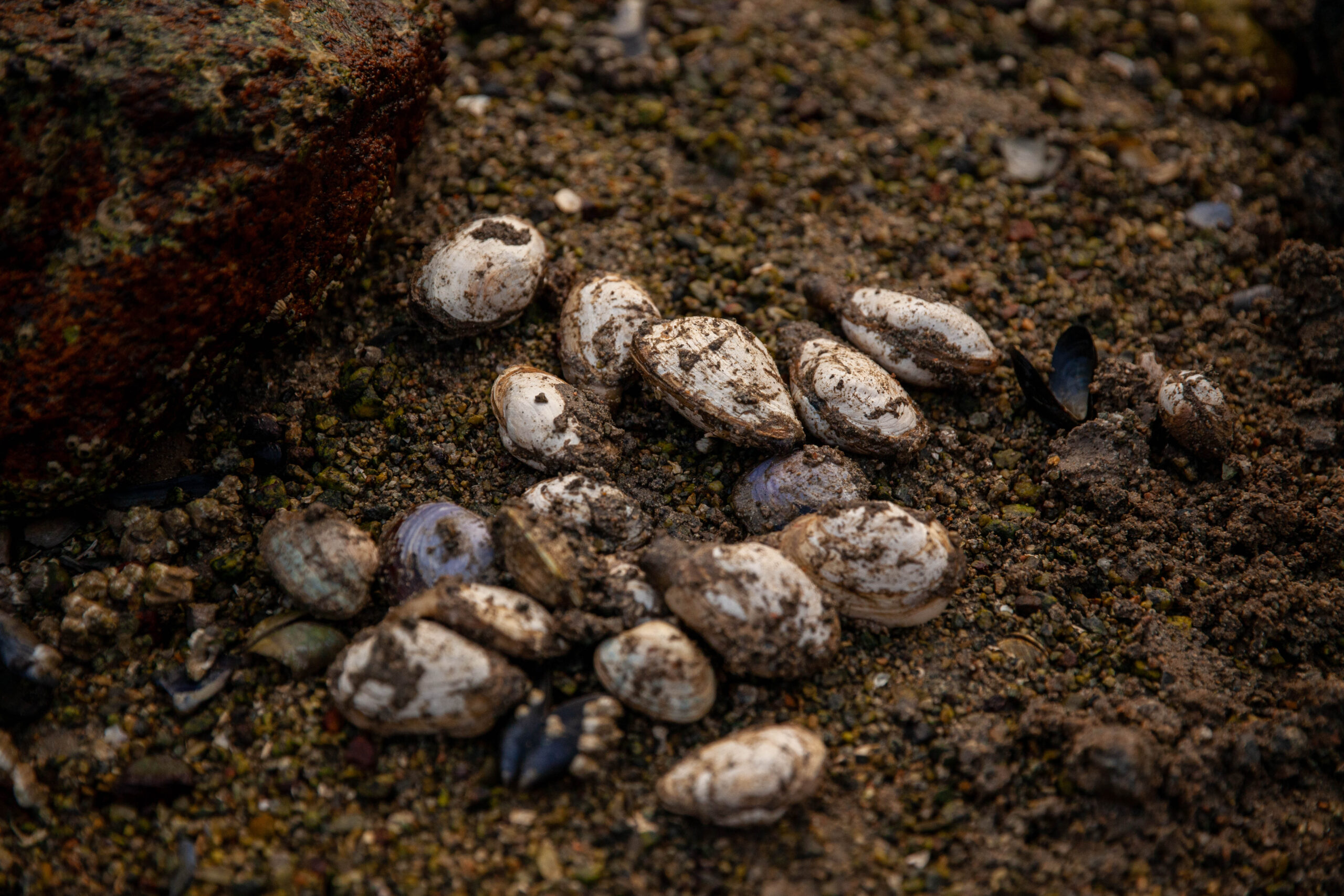
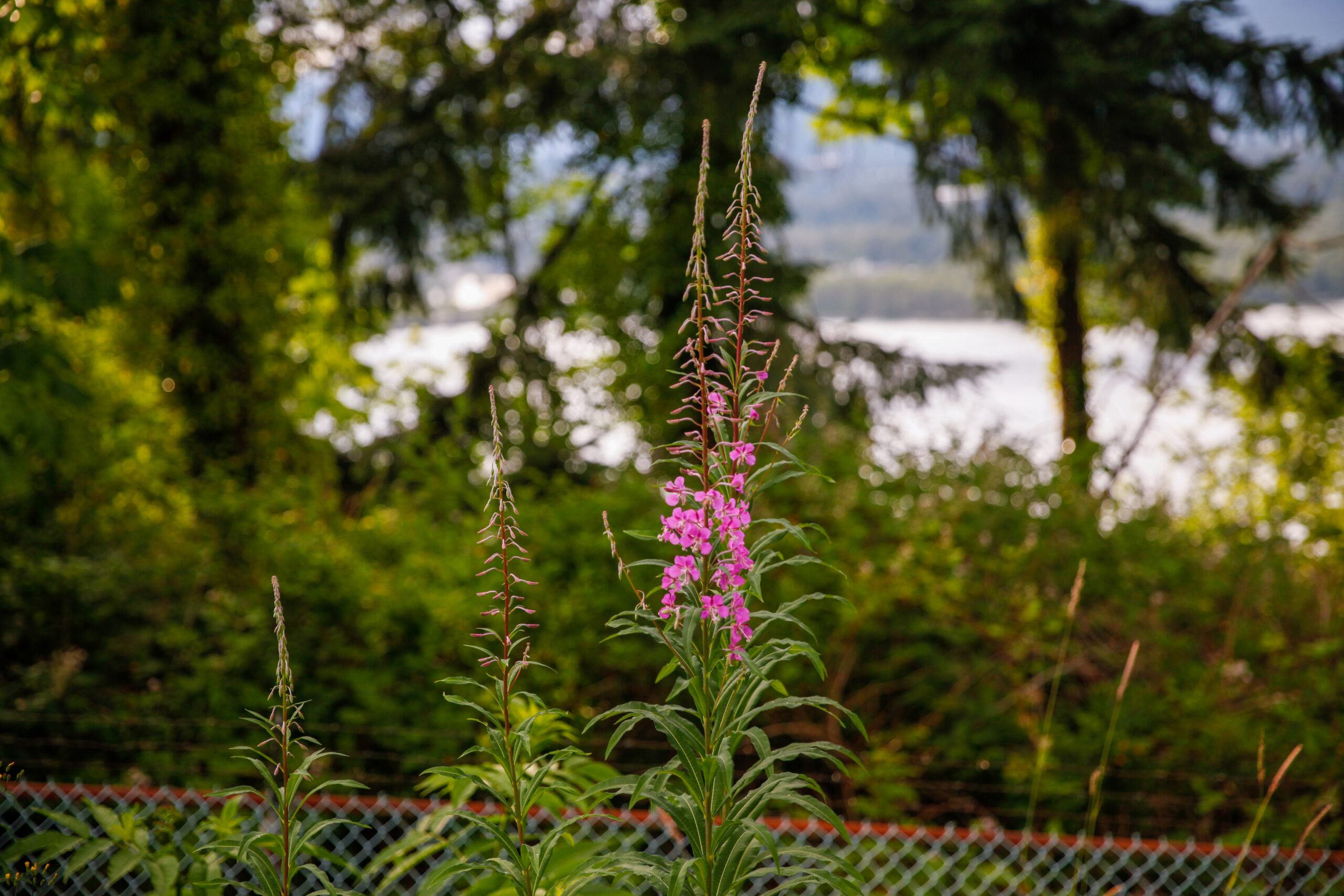
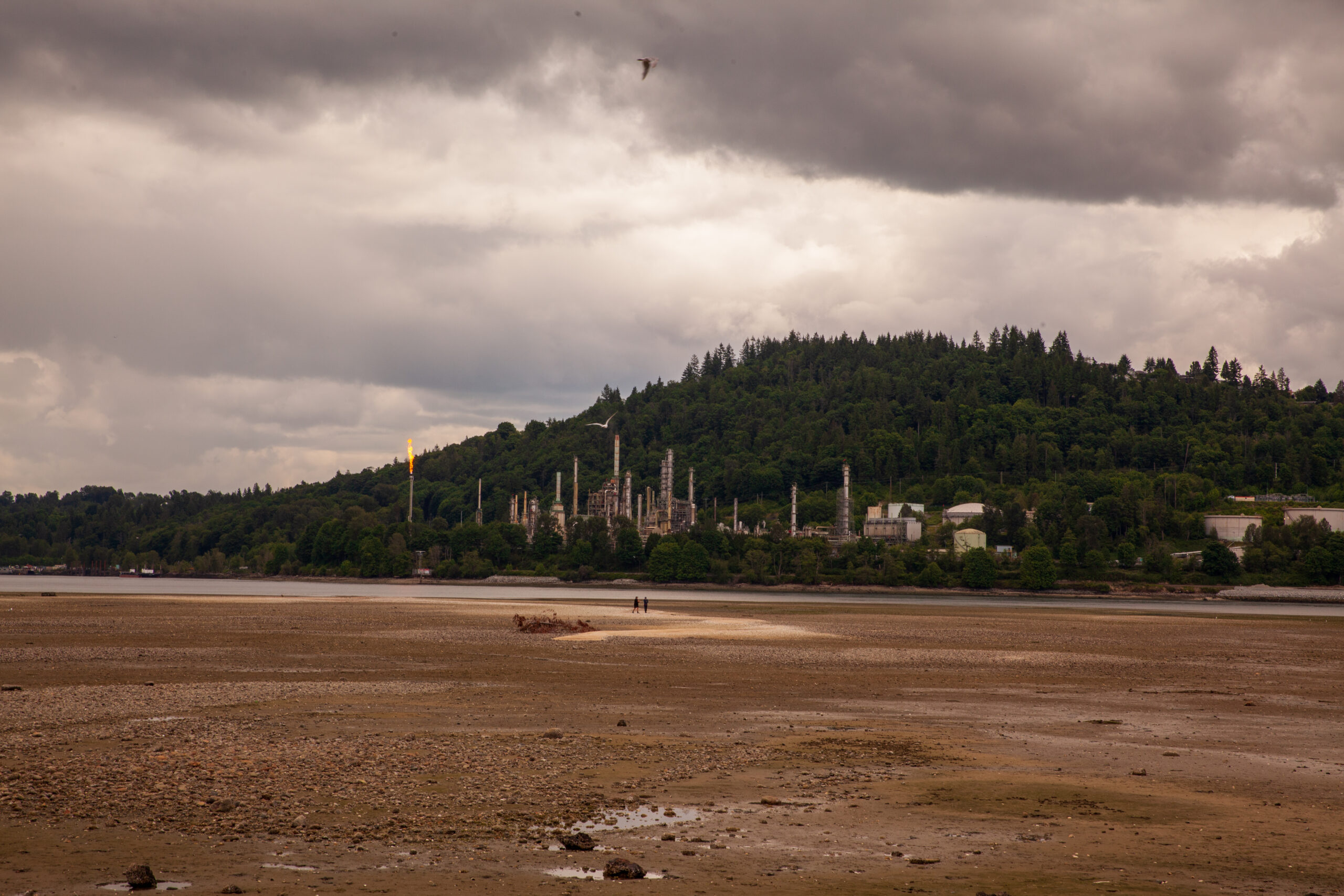
E. coli concentrations alone are often so high that shellfish harvesting is closed to the public.
“Because clams are filter feeders, they’re like the canary in the coal mine for what’s happening in the water column and the sediment,” Lindsey Ogston, Tsleil-Waututh Nation’s environmental programs manager explains. “They concentrate everything that’s happening around them in their body.”
That can include bacteria from human waste, which flows into the inlet from boats, poorly maintained septic systems and surrounding cities, as well as a whole range of contaminants from industry.
For Tsleil-Waututh people it’s meant the loss of another traditional food source.
“Even in my time, our families used to gather and go down to the beach and it would be like a seafood bake,” Micheal George, Michelle’s dad and a cultural advisor with Tsleil-Waututh Nation, says. “We just called it lunch.”
“You’d walk out and get some clams,” he says, “All you needed was a stick, you know, just to go poke them out of the sand and the mud.”
“That’s a huge part of who we are as Tsleil-Waututh people, People of the Inlet, is having that cultural exchange down at the beach,” Michelle says. “You would learn about the water, who we were as canoe paddlers, the history tied to the inlet.”
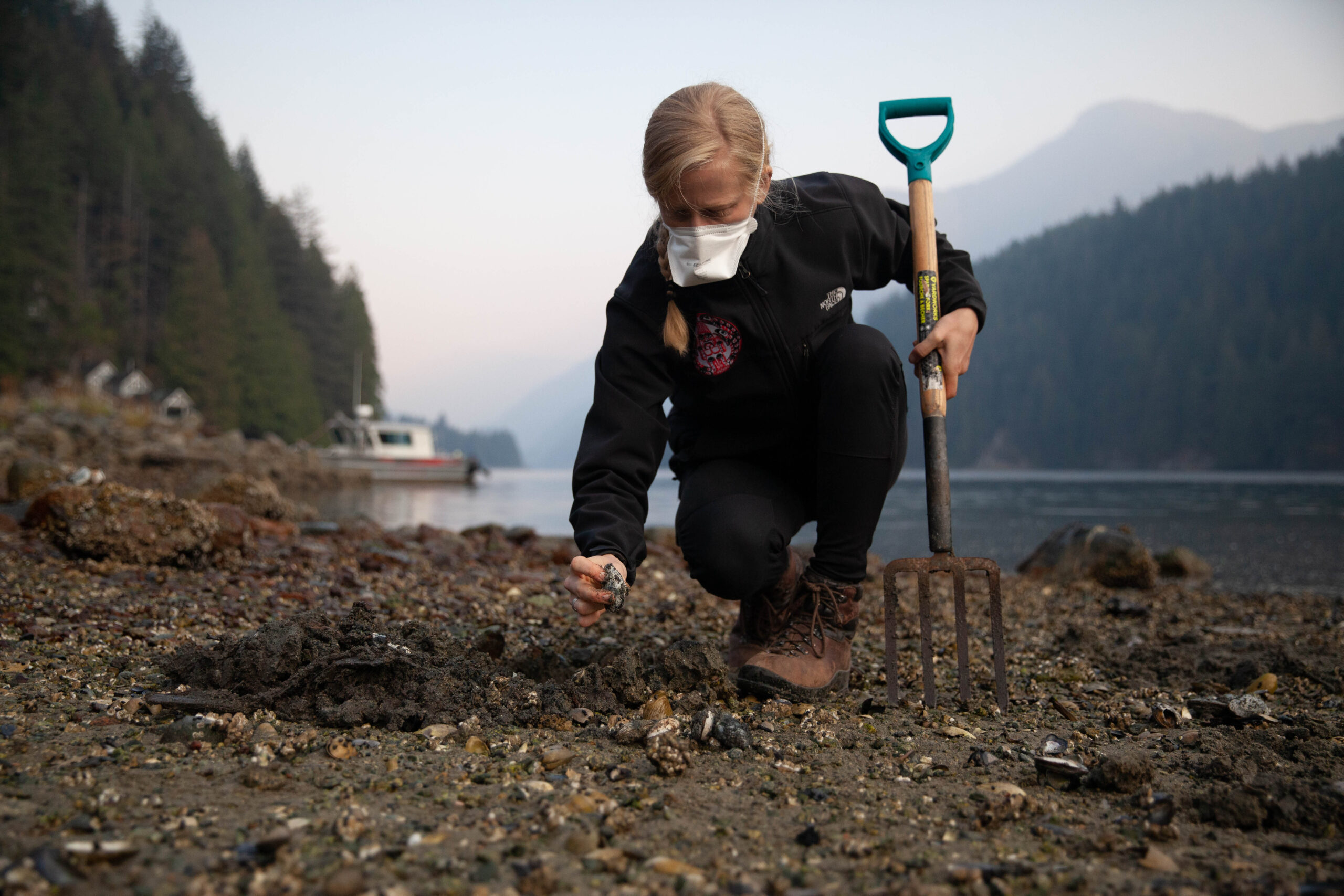
Today — and only with careful monitoring — the community can occasionally harvest a small number of clams for food from one small beach in a portion of the inlet that’s seen less development.
But it doesn’t always work out.
As the nation’s field crew heads out to sample clams for the 2022 harvest, they know there’s a risk bacteria could thwart the community’s plans.
“What we’re worried about now is that it’s supposed to rain a bunch on Friday,” Crozier, the lead natural resource technician says, as the boat putters through the inlet. “Our big concern is that fecal coliform levels spike,” she says.
In urban areas, heavy rains can overwhelm outdated wastewater infrastructure, sending untreated sewage and runoff pouring into the inlet. But even at a more remote area, like this beach, heavy rains can flush detritus and animal feces into the water, raising bacteria levels.
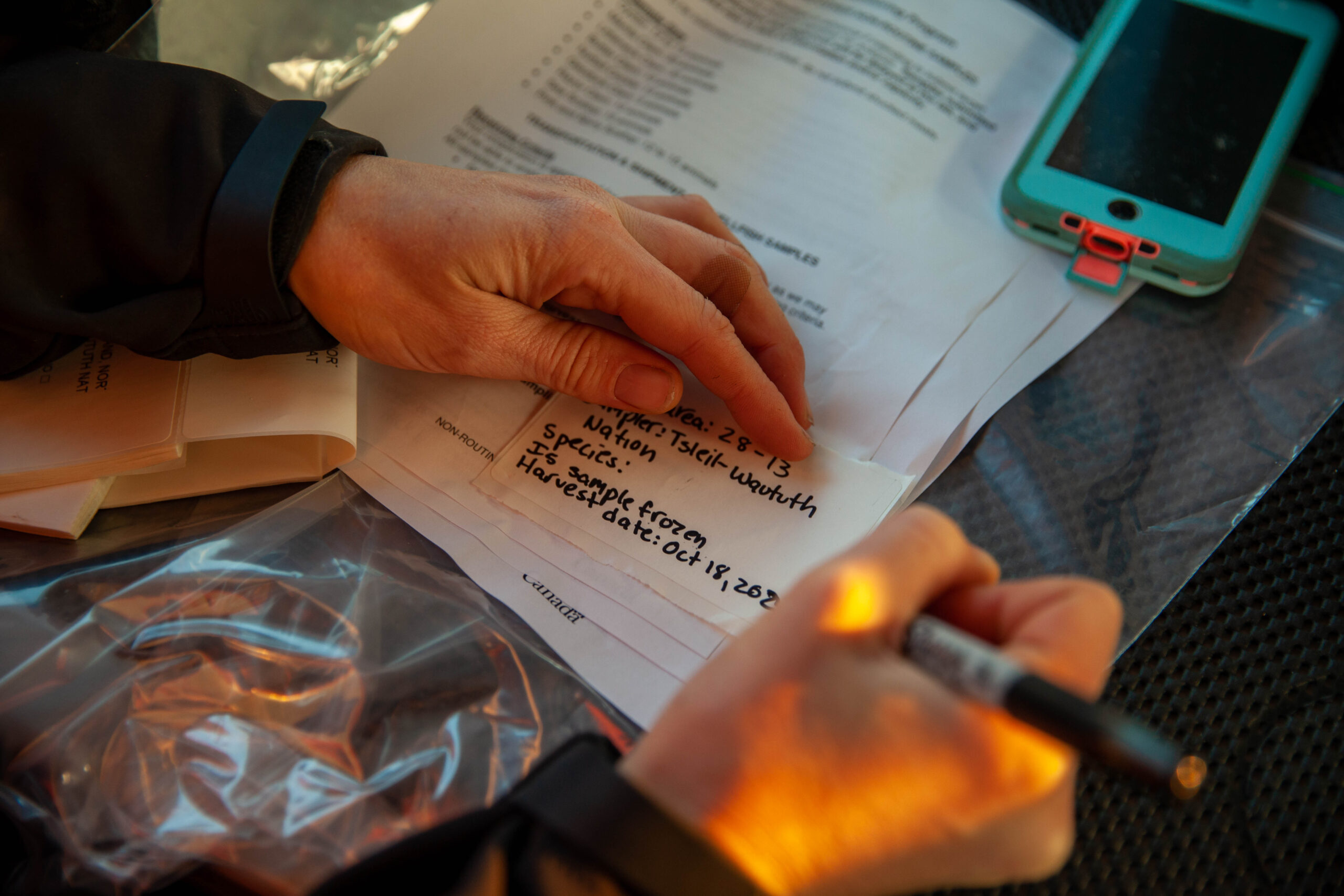
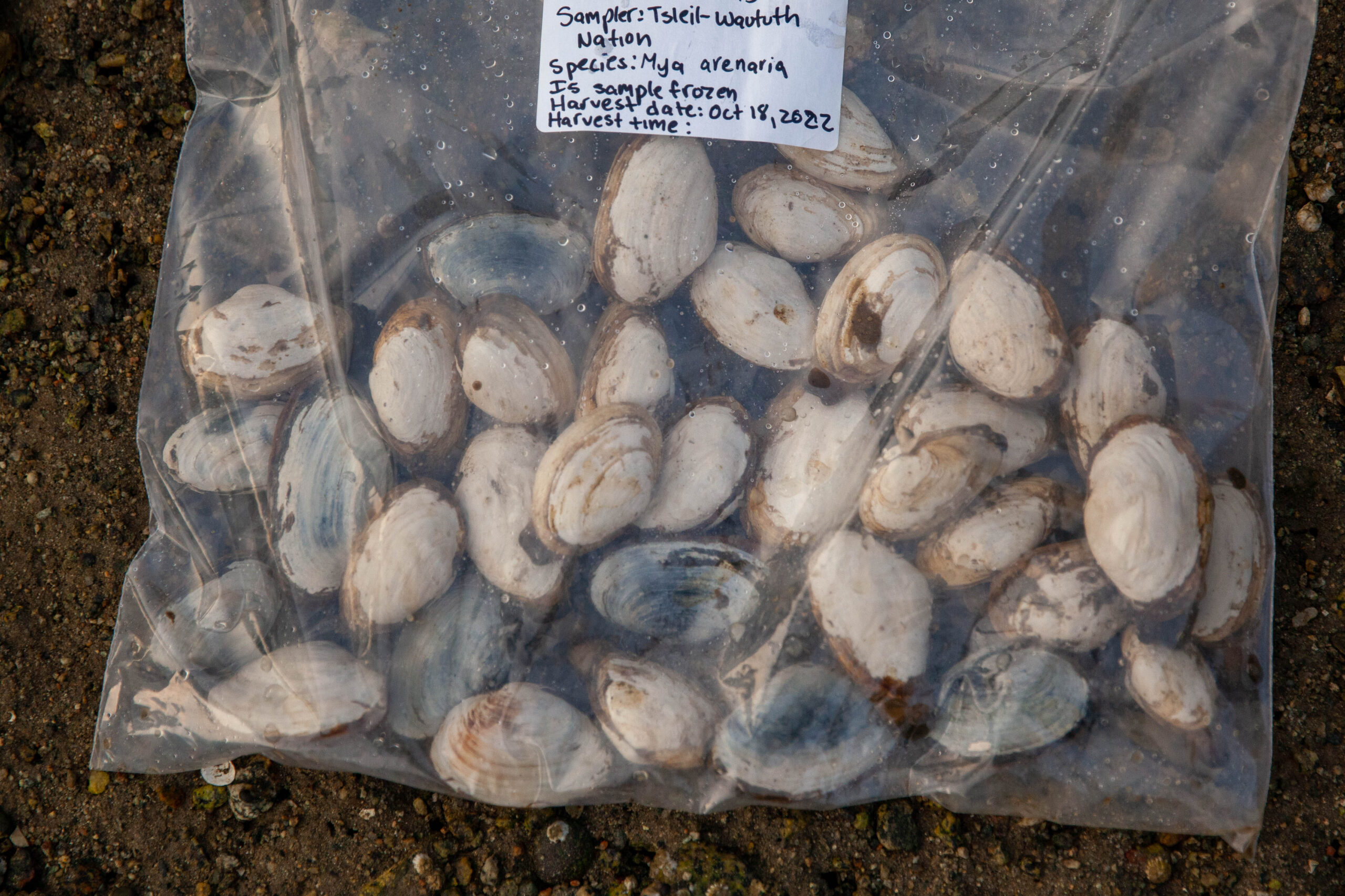
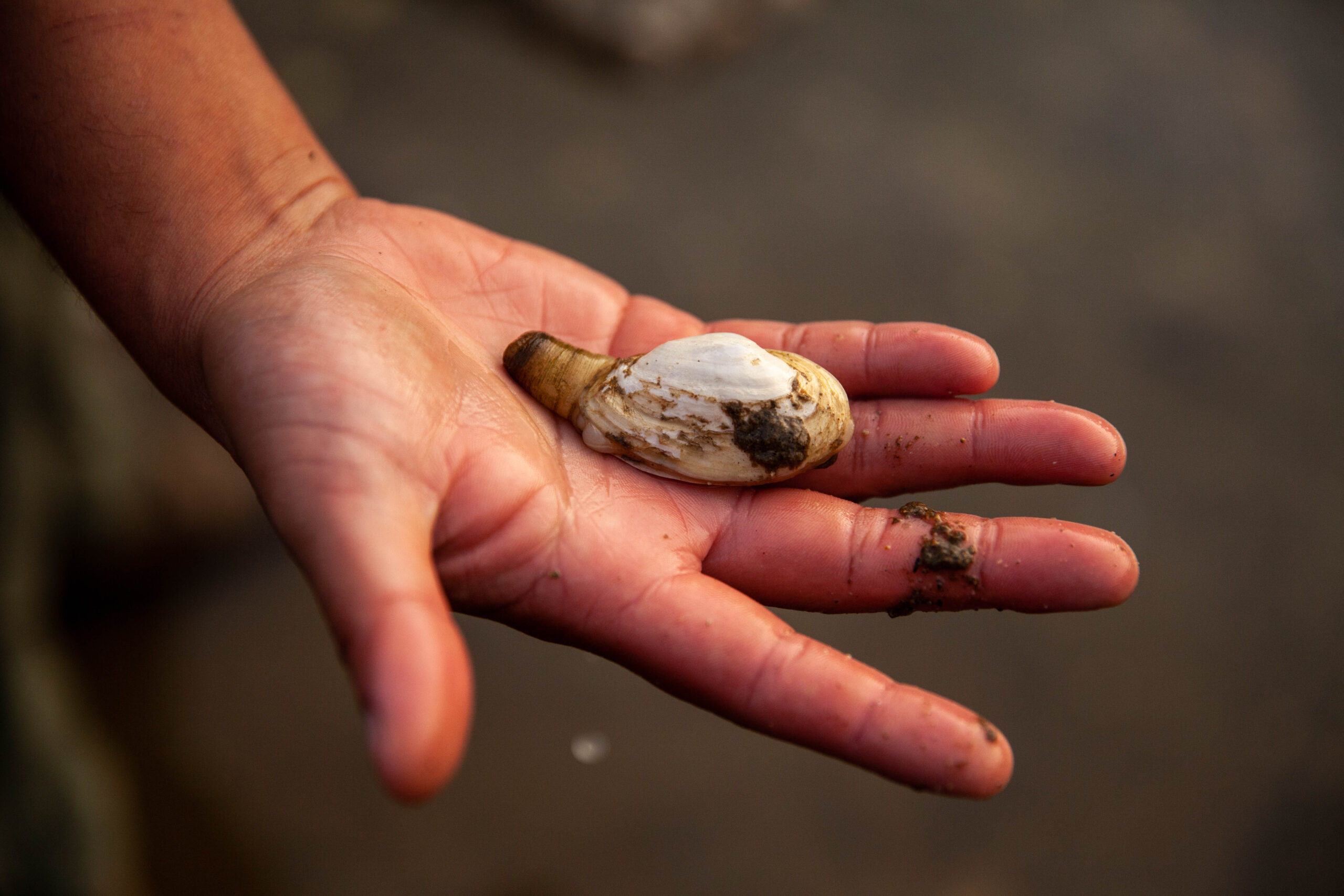
Charlie, a natural resource technician, steers the boat towards a rocky outcrop. It smells gross up here, he says. The smoke is getting heavier.
As Charlie edges the boat towards the rocks, Travis, who is also a natural resource technician, lowers the landing ramp and hops out to tie off the boat before heading down to the beach.
The tide is coming in fast, but it doesn’t take him long to find the clams he’s after. Little fountains of water spurt up through the sand as he digs a shallow hole. He checks each clam to make sure its delicate shell is still intact. Otherwise, they could turn rancid before reaching the lab for testing, he explains.
Crozier collects the clams in a large, clear resealable bag. Back on the boat, she stores them in a cooler to keep them fresh until testing.
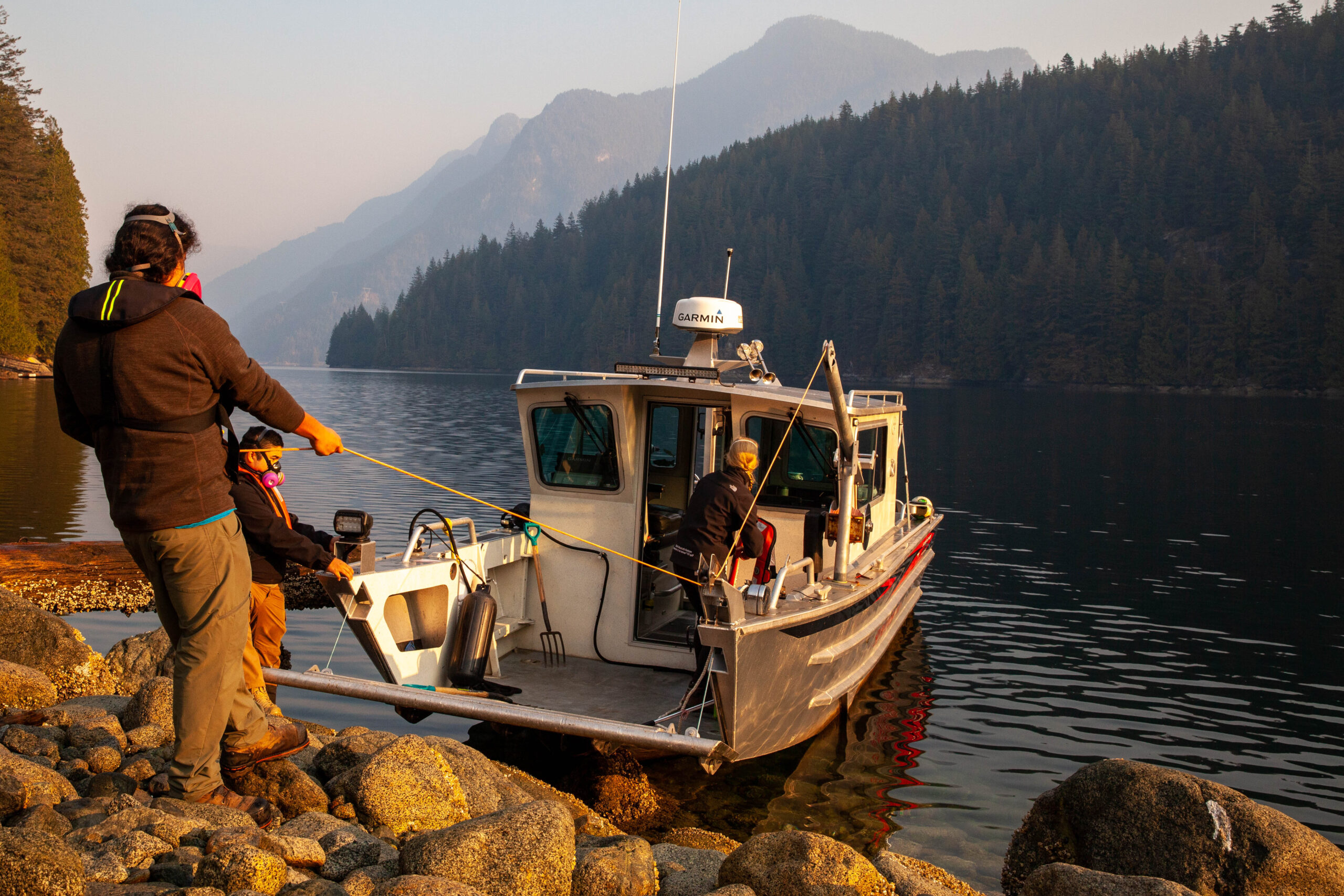
Despite the intensive industry and persistent pollution, the water around this one small beach is sometimes clean enough that the clams are safe to eat. In 2021, the nation was able to harvest about 14 kilograms of clams for food. Though significantly less than their families would have harvested in the past, it’s also a sign of resilience in the face of enormous pressure.
“They tried really hard to demolish us and remove us from our land and erase our Indigenous way of life,” Councillor Aleck says. But “we’re still here. And the same with the land.” The inlet is still “trying to thrive,” she says.
For years now, Tsleil-Waututh Nation and partners have been helping it along, removing derelict pilings soaked in creosote, rejuvenating salmon habitat in the Indian River (xʔəl̓ilwətaʔɬ) and restoring eelgrass meadows next door to chemical plants.
Eelgrass is vital habitat for young salmon and other small fish, offering abundant food and a hideout from predators. “It’s like little fish daycare,” Ogston, the nation’s environmental programs manager, says. But it’s also highly sensitive to contamination and physical disturbance, and much of the eelgrass that once thrived in the inlet was destroyed long ago.
The nation mapped what little was left with underwater cameras and set out to coax these lost meadows back to life, hoping to draw back some of the forage fish they once supported as well. While there’s much more work to do, there are signs it’s already making a difference.
“We got to see a herring return,” Michelle says, something she’d never witnessed in səl̓ilw̓ət before.
The herring drew eagles, herons, seals and sea lions in to feed.
“The work that we do, a lot of the time, you’re sitting in a meeting, talking business, talking permits, talking project review, talking policy and all these other things that are usually tied and bound by red tape,” Michelle says.
It’s witnessing moments like the herring return that keep her going. “It was amazing,” she says. “To have stuff actually come back and use the waters was very cool.”
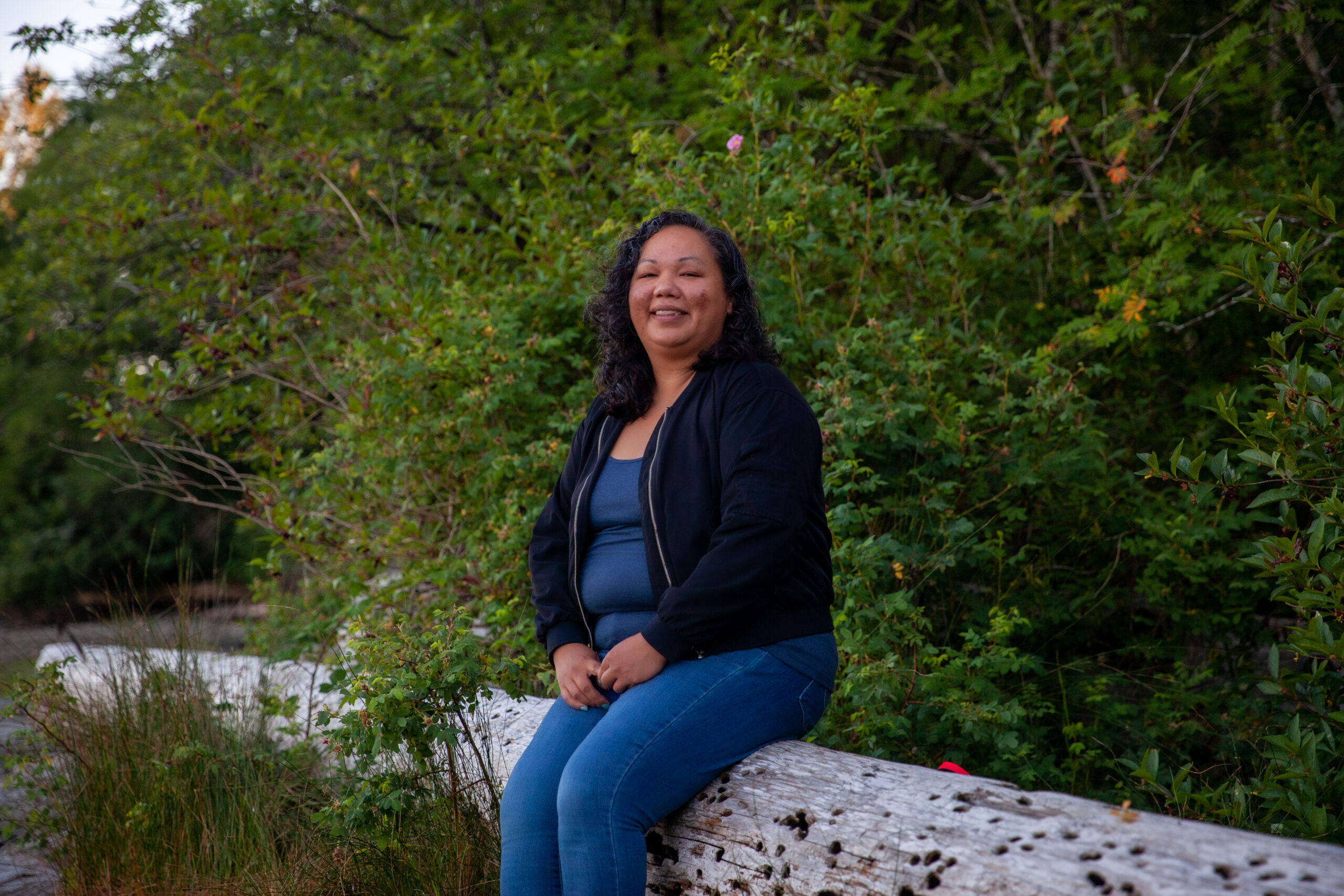
But all those meetings with other governments and industry are making a difference too, albeit slowly. Tsleil-Waututh is leading a project with the B.C. government to establish new water quality objectives that, if achieved, would make the water safer for all living things. The nation signed an agreement with the federal government in 2021 that sees Tsleil-Waututh receive $20 million over 10 years towards environmental science and restoration work in the inlet. And, after years of negotiation, the nation and the province finalized a stewardship plan last year to restore the Indian River (xʔəl̓ilwətaʔɬ) watershed, which strengthens Tsleil-Waututh Nation’s say in decisions about potential resource development in the 22,000-hectare area.
Neither the federal nor provincial ministers responsible for Fisheries or the Environment granted The Narwhal an interview for this story.
In an emailed statement, a spokesperson for B.C.’s Ministry of Environment and Climate Change Strategy, said the ministry “is working with First Nations, Metro Vancouver, member municipalities and other stakeholders to protect and preserve the Burrard Inlet for future generations.”
The ministry is also working with Metro Vancouver and its member municipalities to ensure liquid waste management plans are reducing contaminant levels in the inlet, the statement said. But it could be years before sewage overflows are completely eliminated. The City of Vancouver, for instance, is working to separate combined sewers with an eye to ending overflows by 2050.
A spokesperson for Environment and Climate Change Canada, which is responsible for the pollution prevention provisions under the Fisheries Act, noted in a statement that the department’s enforcement officers can conduct inspections and take enforcement action when there’s evidence that pollution laws have been violated. The statement notes the Greater Vancouver Sewerage and Drainage District was fined $110,000 for releasing untreated sewage into Burrard Inlet in 2011, a problem that persists today.
The department is also working to establish joint decision making with Tsleil-Waututh Nation over disposal at sea activities in Burrard Inlet, the statement noted.
A spokesperson for Fisheries and Oceans Canada, meanwhile, noted its involvement in various fish habitat restoration projects in Burrard Inlet and the Indian River (xʔəl̓ilwətaʔɬ) watershed.
But challenges remain both on the ground and in colonial halls of power.
Decisions that affect the fate of the inlet are still made without Tsleil-Waututh’s consent. The Trans Mountain Pipeline Expansion, which would see a considerable increase in diluted bitumen transported through the waterway, is a glaring example currently under construction. The nation, which conducted its own assessment of the project, remains resolutely opposed to it, citing significant risks to the environment and community. In a statement earlier this year Aleck said the project threatens Tsleil-Waututh’s “very identity as ‘People of the Inlet’.”
Tsleil-Waututh pursued multiple avenues to stop the federally owned project. Tsleil-Waututh Nation, Squamish Nation, Coldwater Indian Band and others took the government to court — and won — over its failure to initially consider the impacts of increased marine shipping, forcing it to reconsider the whole project. They’ve pressured investors on Wall Street. Still, the federal government pushes forward even as project costs soar.
New projects in Burrard Inlet aren’t just causing minor effects, they’re adding the “100th or 200th level of impairment or damage to this system,” Morin says.
In a place already burdened by so much development, Tsleil-Waututh wants a say in what happens next.
In the meantime, Tsleil-Waututh Nation continues with restoration projects and diligent monitoring in the hopes of being able to harvest a small amount of clams each year. But they face challenges out on the water too.
From the beach where the field crew collected clams for testing, they head back into the inlet and make their way to a buoy where a mesh bag of mussels sits suspended in a crab trap in the water.
Charlie slows the boat to a putter as we near the buoy. As it comes into focus, they notice graffiti. “Who the heck goes and graffities a buoy?” Crozier says. “You have too much time on your hands.”
“At least they didn’t take our setup,” she says. The mussels, tested as a proxy for water quality, have been stolen more than once — the last theft put a community harvest at risk.
It’s “frustrating,” Charlie says.
And “it feels targeted at this point,” Crozier adds, because it’s labelled, “it says, ‘toxic mussels, Tsleil-Waututh Nation’ and it has our permit number on it.”
The crew pulls the mussels from the crab trap and heads to the other side of the inlet where another set is waiting.
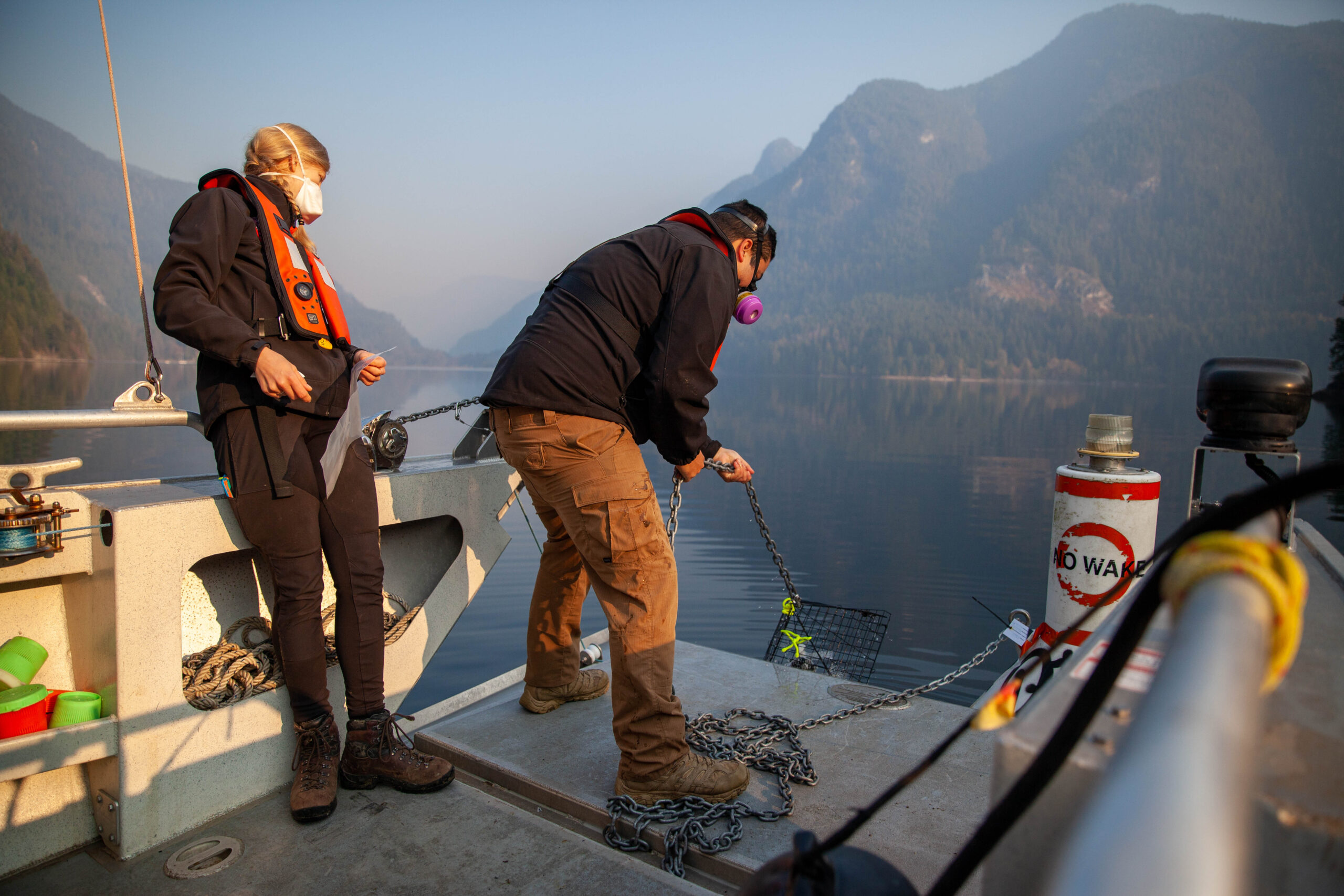
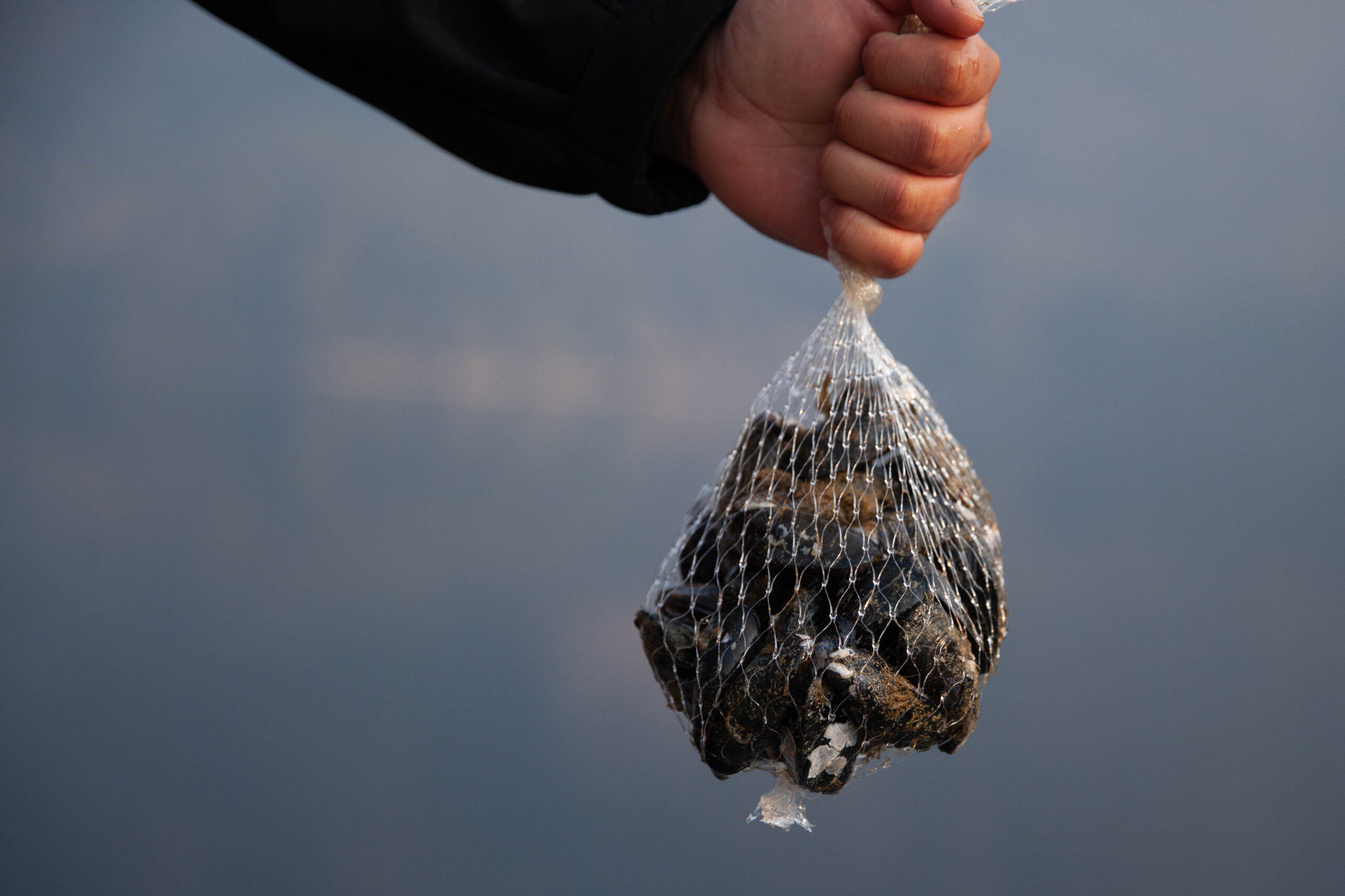
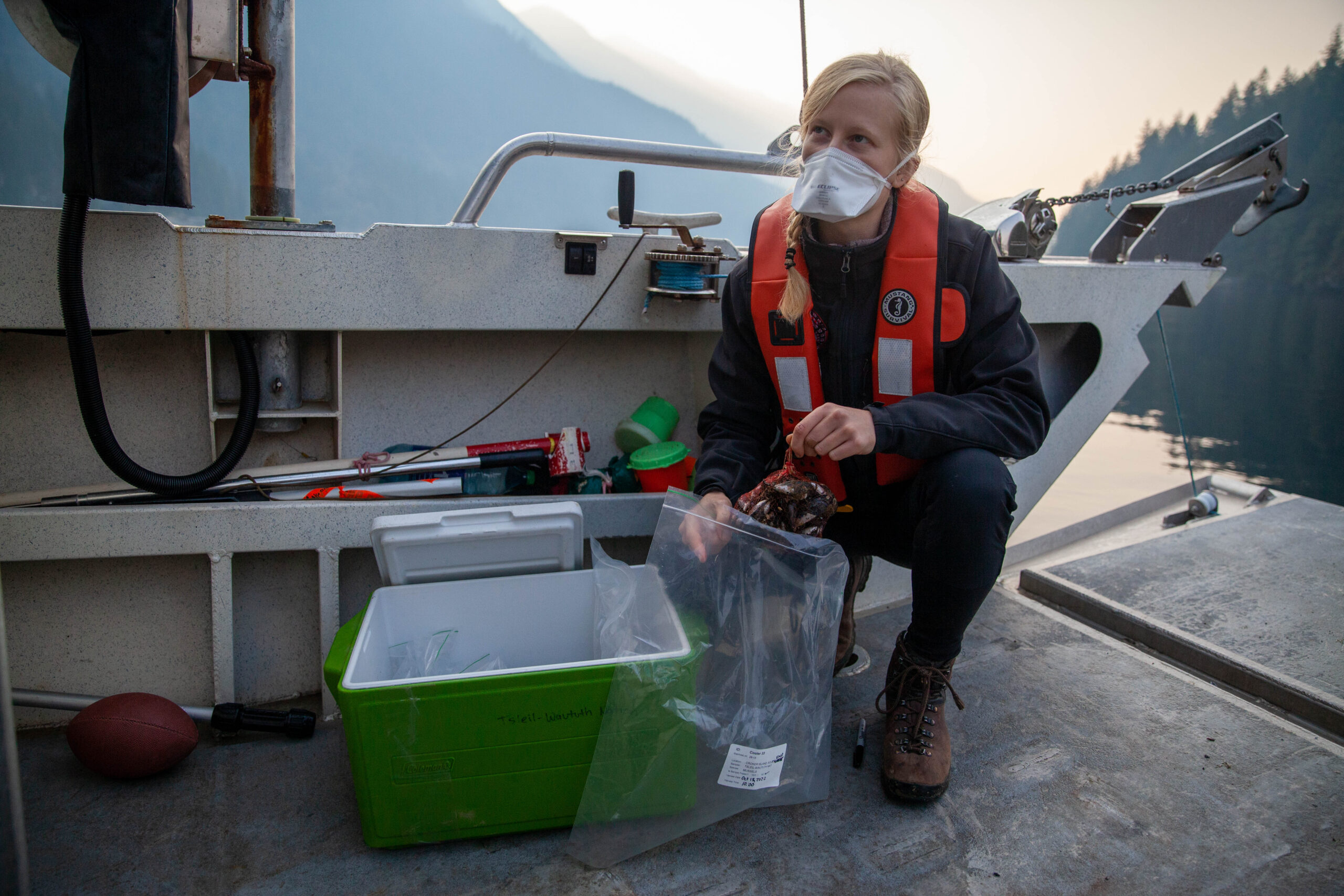
Despite the haze and the heavy conversation, the mood on the boat is mostly light. This crew has known each other a long time and it shows in their easy banter. As Travis pulls the bag of mussels from the second crab trap, he playfully lets it drip over Crozier’s shoulder. She quickly ducks away with a laugh.
With the clams and mussels they need safely stored in the cooler, Charlie, back at the helm, heads for the marina.
Travis turns to his phone and scrolls through his music. As Zack de la Rocha’s Digging for Windows starts playing through his portable speaker he grabs a snack size bag of chips and hands another to Charlie.
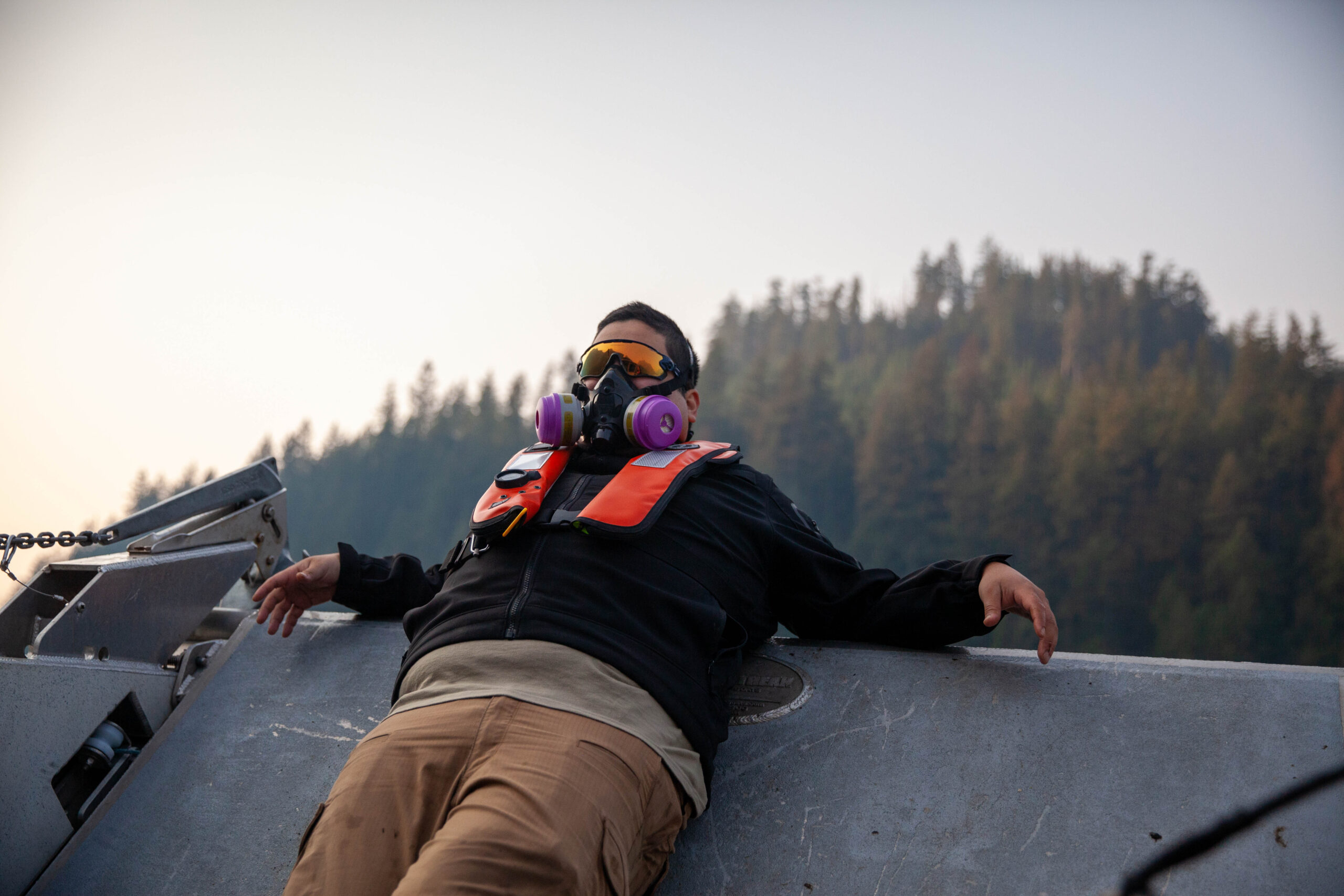
“Holy smokes, it’s bad out here,” Crozier says — pun intended. The haze drifting through the region from wildfires burning to the south has only gotten heavier as the day wears on. It’s an unsettling reminder that climate change is yet another threat to this place.
As Charlie putters the boat in towards the dock, Travis moves to tie off the stern. Crozier secures the bow. From here, she’s off to the lab to drop off the clams and mussels for testing.
Ultimately, the 2022 harvest was postponed. Heavy rains meant the risk of contamination was too great. But several months later, the field crew’s monitoring paid off, and in February 2023 the community was able to collect about 15 kilograms of clams.
“It’s a win” to be able to harvest even a small number of clams for food from an area so heavily affected by industry, Aleck says in April. But she doesn’t want to suggest that everything is somehow okay. “Because it’s still not.”
Fifteen kilograms isn’t even enough for each member of Tsleil-Waututh Nation to have a single meal of clams. What it is, however, is a sign of hope for the future.
“We know we can’t get to the pristine state that she once was,” Aleck says of the inlet. “But we can see her thrive.”
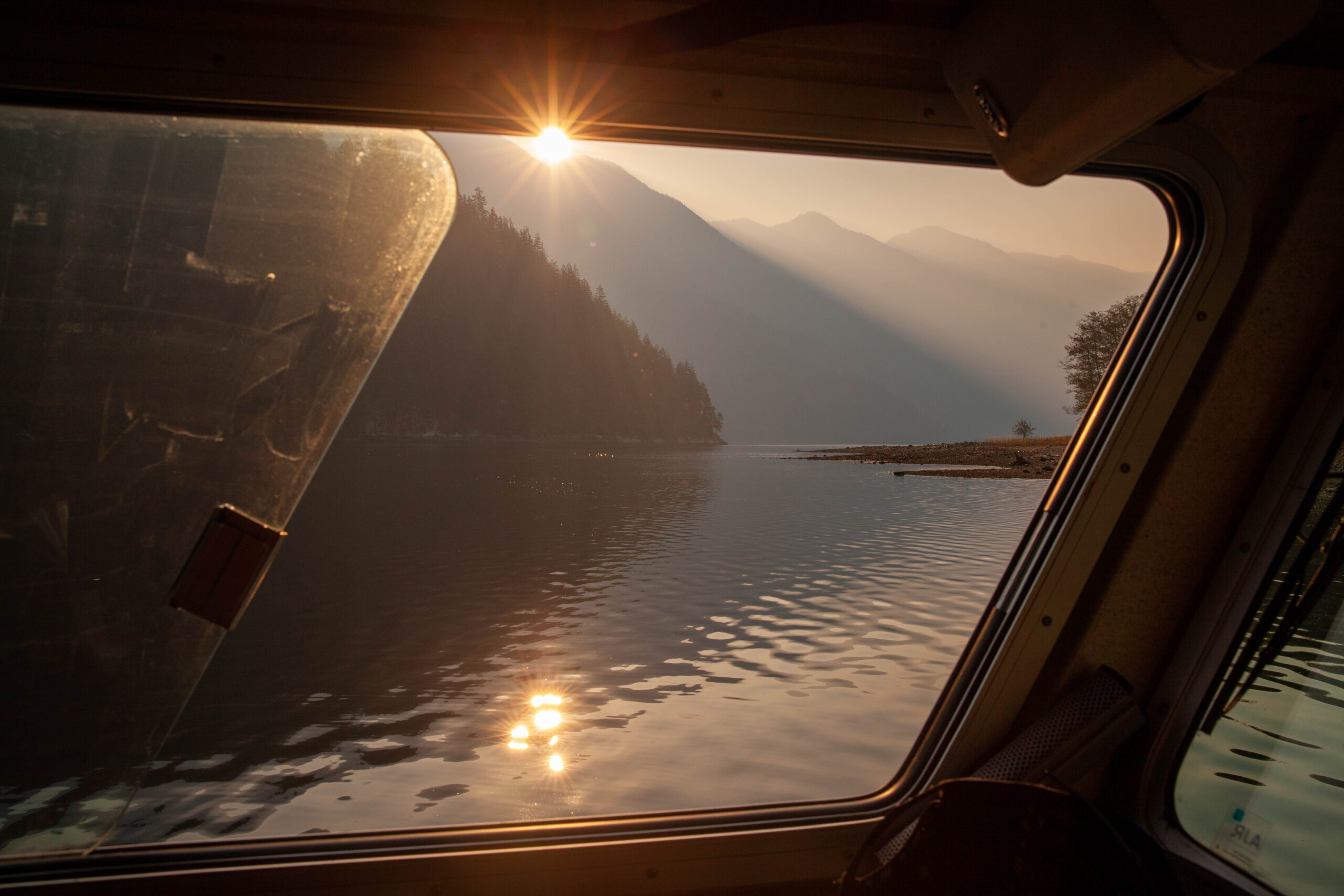
The second photo in the parallax scroll element is a 1937 view of downtown Vancouver and Burrard Inlet from the City of Vancouver Archives.
Editor’s note: To protect the exact location of where Tsleil-Waututh Nation is occasionally able to harvest clams from poachers, The Narwhal shared photos from the clam sampling with the nation before publication. Upon review, The Narwhal agreed not to publish a handful of photos that could identify the location.
